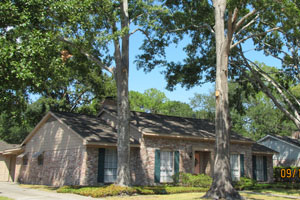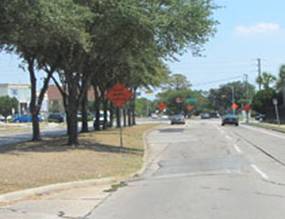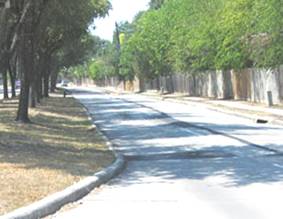The Effect of Trees on Residential Foundations
By: Fred Willcox
Copyright© 2011
All Rights Reserved.
Worried about the effects of the trees around your house? Ever wonder about all those stories about trees damaging shallow foundations normally used to support residential structures in the Greater Houston area? Some of those stories are actually true. But many are not.
So, let’s talk about some reality. First let’s talk about pine trees. Pine trees are tap root feeders. Tap roots go straight down into the ground. Pine trees have almost no effect on the performance of shallow foundations.
Hardwood trees such as oaks, ash and elms have shallow root systems. Builders like to plant these types of trees around their houses as these trees grow quickly. They grow quickly because they use a lot of water. The roots of these type trees branch out as far as and a little farther than the edge or drip line of the leaf mass. These trees get the vast majority of their food under their leaf mass. Whether or not these trees will damage your foundation depends on a few factors.
One factor is the type of soil on which your house is built. Gravels, sands and silts that are fairly dry and well compacted may not be affected by trees at all. While the tree will be pulling water out of the soil mass, if the soil mass is already well compacted or consolidated, little volume loss to the soil mass can occur from the extraction of the water from the soil.
If the gravel, sand or silt is loose or not well consolidated, the movement of water through the soil mass will weaken the frictional “bond” between the soil particles and cause the soil mass to lose volume. The loss of volume of the soil mass supporting the foundation can cause differential foundation movements. The loss of soil volume does not have to occur under or immediately adjacent to the foundation for foundation movements to occur. A tree some distance from the house can affect foundation performance. As the tree causes the soil mass to consolidate, soil particles will “flow” into voids or low areas.
Expansive clays shrink down and away from a foundation when the soil mass is dried. Trees that are close enough to the foundation or that overhang the house can cause the soil under the house to be drawn down and away from the foundation. Remember that the surface of a clay soil cracks when the soil shrinks. This means that the soil moves vertically and horizontally. As the soil shrinks down and away from the foundation, the foundation loses support and hangs over the void like a diving board over a swimming pool. Whether or not the foundation will move differentially depends on the design and the construction of the foundation. If the foundation has deep grade beams spaced fairly close together, to make this simple, if your house is fairly new, the odds are that your foundation can stand the loss of support for a long time. Older foundations that have shallow grade beams lack the rigidity to resist deformation or “settlement” when the soil moves away from the foundation.
Trees can have a devastating affect on the performance of the foundation, depending on the ages of the trees and the age of the structure. As the tree grows it dries or desiccates the soil mass where the tree is drawing its water supply. If the tree is mature when the foundation is constructed the tree will have dried the soil. In this case, such as in the photo shown below, the foundation is not likely to ever suffer “settlement” as the soil will not shrink anymore.

If trees are planted around a foundation when the house is constructed, the removal of water from the soil mass by the tree can cause foundation ‘settlement’. Shown below are photographs of a street that show the affects of trees on the street. Streets are not as rigid as are most newer foundations but the point of the affect of the trees on the street, and possibly on your foundation, is clear.


Of course, if the trees die or are cut down, water will flow into the soil mass. In gravels, sands and silts, this can cause the loss of the frictional bond between the soil particles as the soil is “lubricated” by the influx of water. This can cause a volumetric loss in the soil mass as the soil ‘flows’ out from under the foundation to fill the voids created by the removal of the stump or the rotting of the stump and the roots. In a clay soil, the soil will heave as water returns to the mass causing an edge lift to the foundation. As there is no restraint on the amount the soil can swell this edge lift can be devastating to a foundation.
There are two keys to attempting to control the damage a tree can do to your foundation. The first is to control the leaf mass. Orchard growers have found that reducing, or thinning, the leaf mass by 10% of its volume reduces water use by the tree by 30%. The leaf is the means by which water is dispersed into the atmosphere. The fewer the leaves, the less water the tree will use. This, of course, can be taken too far and removing too many leaves can kill the tree.
The second means of limiting the damage to your foundation is to encourage root growth away from your foundation. Trimming limbs well back from your house and encouraging the growth of the limbs, and the roots, to the side of the tree away from your foundation can encourage the tree to seek water elsewhere than from under your foundation providing that there is a source of water for the tree nearby.
Many “experts” recommend that trees be planted no closer than half their anticipated mature height to the foundation. This means that a tree that normally grows to 40 feet in height should not be planted within 20 feet of the foundation. This assumes, of course, that the tree will grow perfectly vertically and that the leaf mass will be uniformly distributed on all sides of the tree. There is the consideration that the tree will provide shade for the house which is beneficial for energy consumption.
However, if you want to err on the side of caution, and your lot is big enough to allow it, consider planting trees at least the distance of their mature height away from your foundation.
